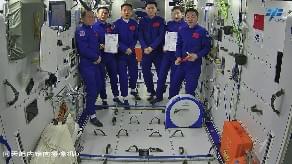Dongfeng Landing Site, Inner Mongolia, north China — Recent (CCTV — No access Chinese mainland) 10. Various of workers in preparation for Shenzhou-14 crew’s return 11. Fast motion of ground radar equipment; vehicles.
In Space — Recent (China Manned Space Agency — No access Chinese mainland) 12. Space station view taken by Tianhe panoramic camera c 13. Fast motion of space station.
The Shenzhou-14 crew, after staying at China’s space station for half a year and performing rotation with their Shenzhou-15 colleagues, is scheduled to return to Earth on Sunday.






